by Heidi Copeland | May 12, 2014
 Not much has changed since the American Academy of Pediatrics released their clinical report in 2006 about the importance of play in promoting healthy child development. In fact, play is so important to optimal child development that in 1989 the United Nations High Commission for Human Rights recognized play as a right of every child. Seriously! Play is essential to child development. Play contributes to the cognitive, physical, social, and emotional well-being of children and youth.
Not much has changed since the American Academy of Pediatrics released their clinical report in 2006 about the importance of play in promoting healthy child development. In fact, play is so important to optimal child development that in 1989 the United Nations High Commission for Human Rights recognized play as a right of every child. Seriously! Play is essential to child development. Play contributes to the cognitive, physical, social, and emotional well-being of children and youth.
Play is a child’s work. Play is how a child learns best. Play is the most effective way to involve every aspect of child development – cognitive, physical, social, and emotional well-being of children and youth. Play allows children to engage and interact in the world around them. Play enhances children’s learning readiness, learning behaviors, and problem-solving skills. Play is a simple joy that we should all remember as a cherished part of childhood.
Nonetheless, children and youth are experiencing decreased amount of child-directed, free unstructured play.
As another school year comes to an ends start thinking about the importance of this free, unstructured, child-driven play this summer. Are you allowing enough time in each day for your child to be running, bike riding, bouncing balls, climbing, and gazing up at the clouds actively using their imagination? Or are they going to be sitting and passively entertained through the screens of a television, computer, video game or even phone?
Think about it, play is a tried-and-true part of child rearing. Play also offers a perfect opportunity for parents to get fully involved with their children and youth.
Don’t buy into the next thingamajig that promises to make your child, better, brighter, happier, or more successful. Buy into the tried, trusted and traditional methods of play! The only thing you have to invest is quality time with your children and youth.
As the clinical report also mentions, adults who share unscheduled, spontaneous playtime with their children are being wonderfully supportive, nurturing and productive. What do you have to lose? Make some time to play today!
by Heidi Copeland | May 12, 2014
 The President of the United States of America, Barack Obama has proclaimed obesity a national, serious public health issue. As such, he is encouraging all Americans to learn about and engage in activities that promote healthy eating.
The President of the United States of America, Barack Obama has proclaimed obesity a national, serious public health issue. As such, he is encouraging all Americans to learn about and engage in activities that promote healthy eating.
How can you get involved? Let’s start with the family meal. There are many benefits to family meals. Families are more likely to eat a nutritious meal when most or all of the family eats together. Plus, families who eat at home have control of portion sizes and ingredient choices. Additionally, children who eat with their families are likely to consume more fruits, vegetables, and whole grains and less fat sugar and empty calories.
Research shows that adolescents are also less likely to smoke, drink, and use illegal drugs during their teen years. Enjoying family meals together enhances family communication and provides opportunities for families to share traditions, recipes and family heritage that can be handed down through each generation. And, family meals improve manners, too!
We are not talking about a Thanksgiving type spread here. A family meal can be breakfast, lunch or dinner. Nutrition experts state the meal does not even have to be enjoyed around the table. The important fact is that it is enjoyed together creating a lifetime of positive memories.
Cooking at home can be an intimidating task, but a rewarding one for you, your family, and your budget. Did I mention health?
Homemade meals are easy once you learn a few cooking basics. Once the basics are understood’ a cook can develop the confidence to be creative and experimental. Using family mealtimes as instructional times can also be a wonderful opportunity for you to teach your children how to cook good, healthy meals too.
Are you wondering how to get started?
The University of Florida, IFAS EDIS publications contain a wealth of information about purchasing, and preparing foods http://edis.ifas.ufl.edu/ (put cooking in the search bar). Another good resource is the Cook it Quick series by Alice Henneman, MS, RD, University of Nebraska Extension in Lancaster County http://food.unl.edu/fnh/cooking-school. Not only will you find quick tips and tricks but you can hone in on cooking techniques as well as find quick, healthy recipes.
Vow to prepare and eat more meals at home. You and your loved ones will be glad you did!
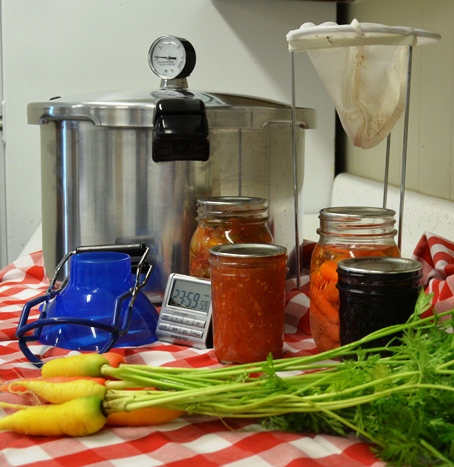
by Shelley Swenson | May 1, 2014
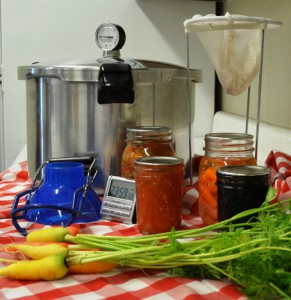
Low-Acid Canning requires a Pressure Canner Submitted by Shelley Swenson/Les Harrison
Home canning has changed greatly in the 170 years since it was introduced as a way to preserve food. Grandma may have cooked her green beans and poured them into hot jars but open kettle canning is not recommended today. Scientists have found ways to produce safe, higher quality products to replace outdated recipes and techniques.
For safety’s sake, pressure canning is the only recommended method for canning meat, poultry, seafood and vegetables. Only through the use of the proper equipment can bacteria be destroyed in low-acid foods when they are processed at the correct time and pressure. Using boiling water canners for these foods poses a real risk of botulism poisoning. If Clostridium botulinum bacteria survive and grow inside a sealed jar of food, they can produce a poisonous toxin. Even a taste of food containing this toxin can be fatal.
What are the secrets of a safe and quality end-product? Process low-acid foods in a pressure canner. Have your gauge checked for accuracy and your gasket for dryness; many county extension offices offer this service. Make sure that you are using up-to date, research-based processing times and pressures for the size of jar, style of pack and kind of food being canned. Utilize the proper processing time and pressure for sterilizing the food at your altitude. Look for jar lids that are firmly sealed and concave and with nothing leaking from the jar after storage. Upon opening the jar, no liquid should spurt out and no unnatural or “off” odors should be detected.
Research-based food preservation recipes and information are available at your county extension office or at the UF/IFAS website http://edis.ifas.ufl.edu/topic_canning_food. When preserving low-acid food there is no room for error. The safety and quality of the end product are factors to be considered.
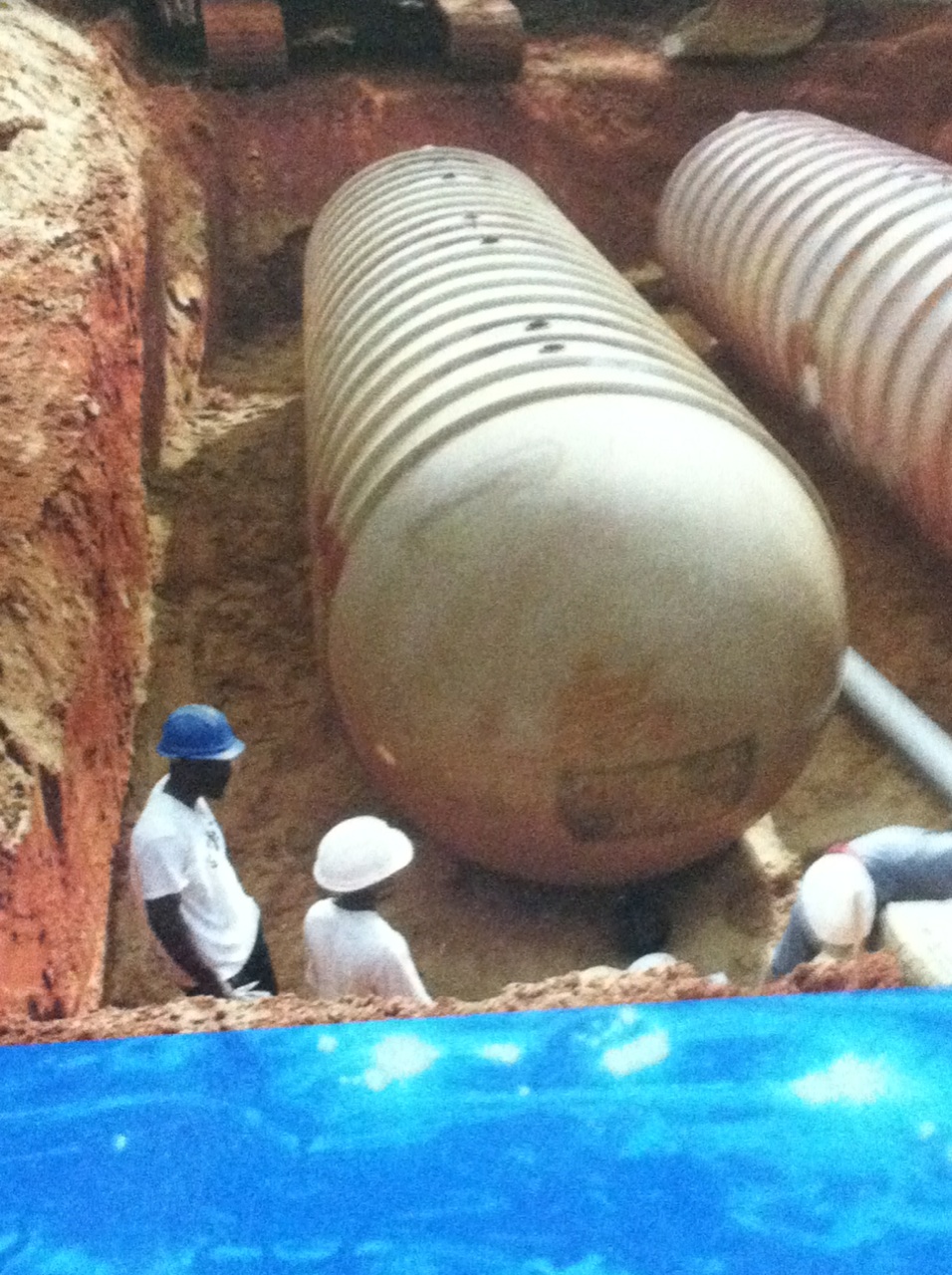
by Heidi Copeland | Apr 25, 2014

Leon County Extension’s sustainable rainwater cisterns collect rainwater from the rooftop and use the water from the cisterns to irrigate the demonstration garden.
According to the Environmental Protection Agency (EPA), the term “sustainability” has emerged as a result of significant concerns about the unintended social, environmental, and economic consequences of rapid growth. Sustainability is based on a simple principle: Everything we need for our survival and well-being depends, either directly or indirectly, on our natural environment. Therefore, sustainability creates and maintains the conditions under which humans and nature can exist in harmony, fulfilling the social, economic, and other requirements of present and future generations.
WHEW! Think about it! Sustainability is important to making sure that we have, and will continue to have, the water, materials, and resources to protect our health and our environment.
Think about it! Water, for instance. Though we might see water as an abundant resource in Florida, water is emerging as a sustainability issue sparking debate and illustrating the differences in opinions of various water users in Florida. Consider these facts:
- Heavy demand: High levels of commercial, real estate, and agricultural development have caused withdrawals to increase over time, putting pressure on natural resources.
- Changes in water use: Agricultural production and public supply are the largest users of freshwater resources in Florida. Large demands occur in municipal water supply systems as a result of landscape irrigation of lawns and golf courses.
- Environmental consequences: Depletion of groundwater resources can have negative environmental consequences, such as saltwater intrusion into freshwater resources and sinkhole development.
- Water use strategies: Strategies to balance water use include reducing the overall demand for water (through such means as increased water prices or restrictions) or increasing the supply of water (through such means as desalination of seawater).
- Water quality: Recent EPA nutrient requirements designed to protect water quality.
Just think about it! Just like there are many levels of sustainability, each and every one of us can draw from advances in science and technology to protect not only our health but the environment.
Just think about it! And then take action. The EPA website has data specific to your area of interest. Information on air, water, land, community, health, and energy can be visualized on a map, downloaded, and printed.
Think about it! Individuals can make a difference! A journey of a thousand miles begins with a single step. Each of us can promote practices to strengthen our natural environment and quality of life, ultimately improving the quality of life for everyone.
Sources: http://www.epa.gov/
UF/IFAS FCS 7242 Understanding Sustainability: The Importance of Sustainable Development and Comprehensive Plans—Goals, Objectives, Policies
UF/IFAS WC151 Water Issues in Florida: How Extension Can Facilitate Stakeholder Engagement and Involvement
by Dorothy C. Lee | Apr 14, 2014
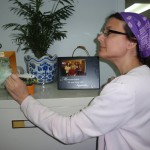
Photo credit: Dorothy C. Lee
Spring is officially upon us. There are few rites of Spring more familiar than the annual Spring Cleaning. It is easier and healthier to live in a clean, well-organized home. Spring Cleaning doesn’t have to be synonymous with drudgery, though.
The key to cleaning is being organized and familiar with the uses of different cleaning products. Today’s cleaning methods and equipment make it more efficient and economical to clean. Be an informed consumer when selecting household cleaning supplies. Selecting a few all-purpose cleaners is more economical and requires less storage space.
Make it easy: Get organized. Gather cleaning supplies. Select a few all-purpose cleaners. Put all of your cleaning supplies, brushes, gloves, rags, etc. into one basket and take it with you as you move from room to room.
Clean with ease. Here are some tips that can help you:
- Clean as you go. For example, make your bed as you get out of it.
- Perform preventive measures to avoid big cleaning jobs later. For example, change filters in heating and cooling equipment regularly.
- Plan ahead. Make a list and check off items as you complete the chore. Establish a flexible cleaning schedule.
- Make sure to follow manufacturers’ directions for use and care of items.
- Incentivize by establishing a goal and rewarding yourself when you’ve accomplished it.
- Get in a cleaning mindset. Put on an exercise DVD and think of cleaning as a workout instead of a chore, or put on music you like to move to and let it energize you.
Consider making your own household cleaning supplies…Granny did! Try baking soda, vinegar, and ammonia for cleaning. These old-fashioned cleaners still work today. Making your own cleaners can cost less and be environmentally safe.
Safety considerations should always be followed when making household cleaning supplies. Never mix chlorine bleach with any other cleaning agents, especially ammonia or vinegar. The combination can create toxic fumes. Do not store cleaning supplies in containers that once held food or beverages – this can lead to mistaken identity and accidental poisoning. Clearly label each container. Store all cleaning supplies out of reach of children. Mix cleaning solutions in a well-ventilated area and clean up after using toxic substances. Store containers tightly closed.
Many household cleaners can be made from inexpensive household ingredients. Following are a few DIY cleaning solutions you can prepare yourself:
Multi-purpose Cleaner
1/2 cup ammonia
1 cup baking soda
2 cups warm water
Mix ingredients in a one-gallon container until baking soda is dissolved, and then add enough water to fill the gallon container. Use ½ cup of mixture in a bucket of water to clean floors, walls, woodwork.
Window Cleaner
Mix together 2 tablespoons vinegar and 1 quart water in a spray container. Spray windows and use crumpled newspaper, if desired, to shine windows.
Mildew Cleaner
3/4 cup chlorine bleach
1 gallon water
Mix and put into spray container. Apply to mildewed area; let stand for five minutes; rinse with water.
Disinfecting Solution
3/4 cup chlorine bleach
1 tablespoon liquid soap
1 gallon water
Mix ingredients together. Wipe surface and let stand for two minutes. Rinse and wipe dry or air dry.
Aluminum Cleaner
1 tablespoon vinegar to 1 quart water or
2 teaspoons cream of tartar to 1 quart water
Add solution to pan and bring to a boil. Boil until discoloration disappears. Empty solution, let pan cool, and rinse.
Consider making your own cleaners before you buy. They cost less and are eco-friendly. Be an informed consumer and spring into cleaning!
For further information, visit the University of Florida/IFAS Solutions for Your Life website.
References:
EDIS publication FCS 3149 Hazardous Household Substances: Alternatives That are Relatively Free of Toxic Effects
“Eco-Friendly Alternatives to Commercial Cleaners and Other Household Products,” Environmental Media Services, www.ems.org
“Safe Substitutes at Home: Non-Toxic Household Products,” EnviroSense, www.epa.gov
by Judy Corbus | Apr 14, 2014
Normal
0
false
false
false
EN-US
X-NONE
X-NONE
/* Style Definitions */
table.MsoNormalTable
{mso-style-name:”Table Normal”;
mso-tstyle-rowband-size:0;
mso-tstyle-colband-size:0;
mso-style-noshow:yes;
mso-style-priority:99;
mso-style-parent:””;
mso-padding-alt:0in 5.4pt 0in 5.4pt;
mso-para-margin-top:0in;
mso-para-margin-right:0in;
mso-para-margin-bottom:8.0pt;
mso-para-margin-left:0in;
line-height:107%;
mso-pagination:widow-orphan;
font-size:11.0pt;
font-family:”Calibri”,”sans-serif”;
mso-ascii-font-family:Calibri;
mso-ascii-theme-font:minor-latin;
mso-hansi-font-family:Calibri;
mso-hansi-theme-font:minor-latin;}
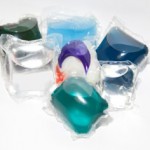
Photo credit: American Cleaning Institute
Are you familiar with the new single-load liquid laundry packets? They are a convenient new laundry product which contains highly concentrated detergent in single pouches. However, if not stored properly, the packets can pose a danger to curious young children leading to injury from ingestion or exposure to the eyes. The American Cleaning Institute urges parents and caregivers to keep these products in a secure location out of reach and sight of young children.
For best results with the laundry packets, follow these tips:
- Like all other cleaning products, keep single-load liquid laundry packets out of the reach of children and pets between every load to prevent unintended exposure.
- For best results, add the single-load liquid laundry packets to the bottom – also known as the drum – of the washing machine, both for top-loader and high-efficiency front-loader machines, before adding clothes. Do not put this product in your machine’s dispenser drawer.
- Do not cut or tear the single-load liquid laundry packets. They are designed to dissolve completely in the machine, even in cold water.
- Read the product label to determine how much product you should use.
- Do not use the single-load liquid laundry packets for washing laundry by hand or to pretreat fabric.
- If the single-load liquid laundry packets stick together, throw them away. The packets can rupture if you try to separate them.
- Handle this product with dry hands only, and remember to close the product container completely after each use to keep out moisture. The film that encases the laundry detergent is designed to dissolve quickly, even in small amounts of water. Store this product away from water.
- Always ensure the re-closable bag or container is tightly sealed after use and during storage.
- As with other laundry products, keep product in its original container with intact labels.
- Store products away from food, as you would with other laundry products.
Take the KEY Pledge (one grand prize winner will receive one electronic gift card in the amount of $2,500.)
- Keep single-load liquid laundry packets out of the reach of children.
- Educate your family and friends about the safe use and storage of these new laundry products.
- You serve a key role in laundry safety.
For more information, watch this short animated video available in both English and Spanish.
Source: American Cleaning Institute
 Not much has changed since the American Academy of Pediatrics released their clinical report in 2006 about the importance of play in promoting healthy child development. In fact, play is so important to optimal child development that in 1989 the United Nations High Commission for Human Rights recognized play as a right of every child. Seriously! Play is essential to child development. Play contributes to the cognitive, physical, social, and emotional well-being of children and youth.
Not much has changed since the American Academy of Pediatrics released their clinical report in 2006 about the importance of play in promoting healthy child development. In fact, play is so important to optimal child development that in 1989 the United Nations High Commission for Human Rights recognized play as a right of every child. Seriously! Play is essential to child development. Play contributes to the cognitive, physical, social, and emotional well-being of children and youth.






